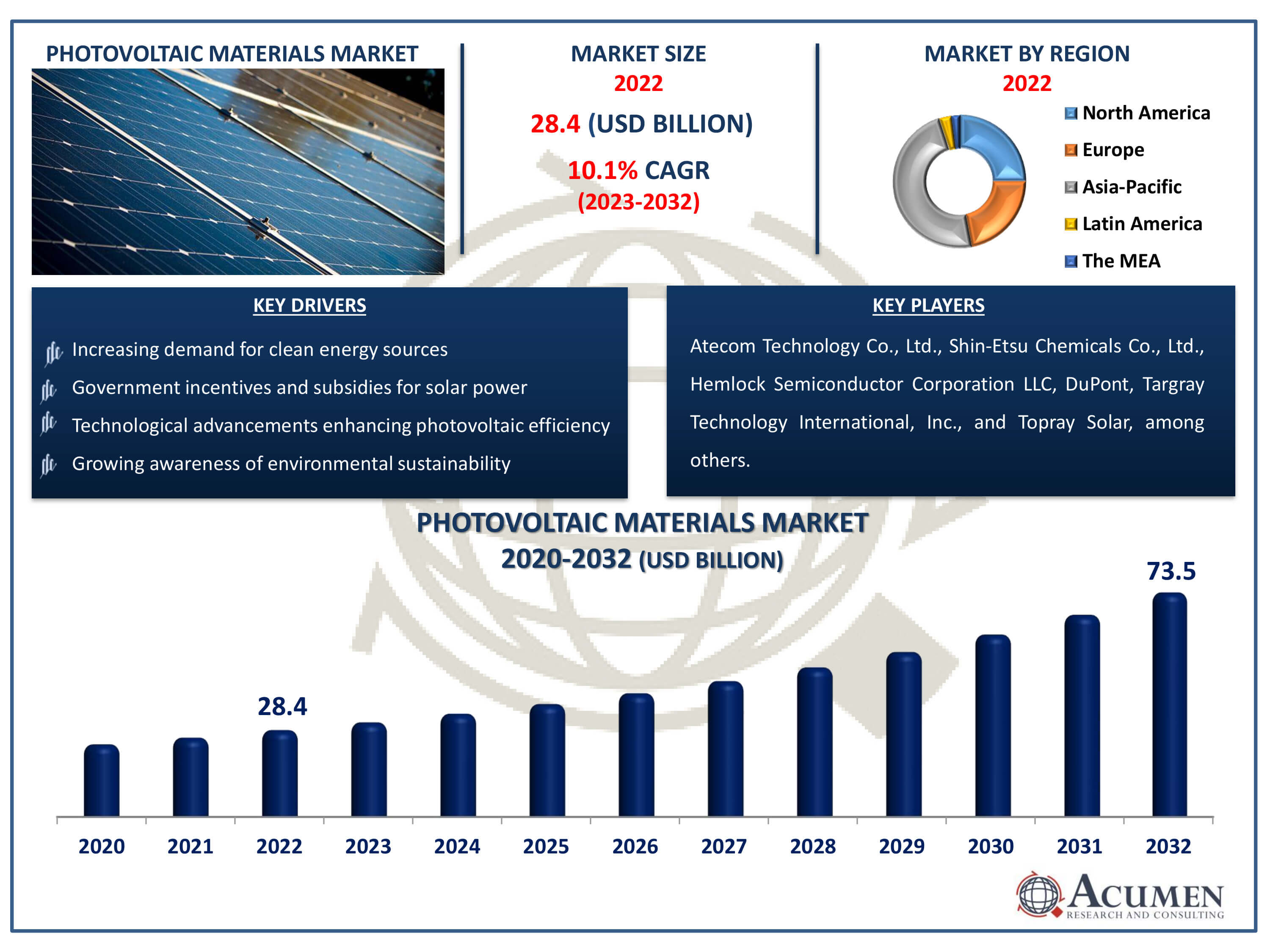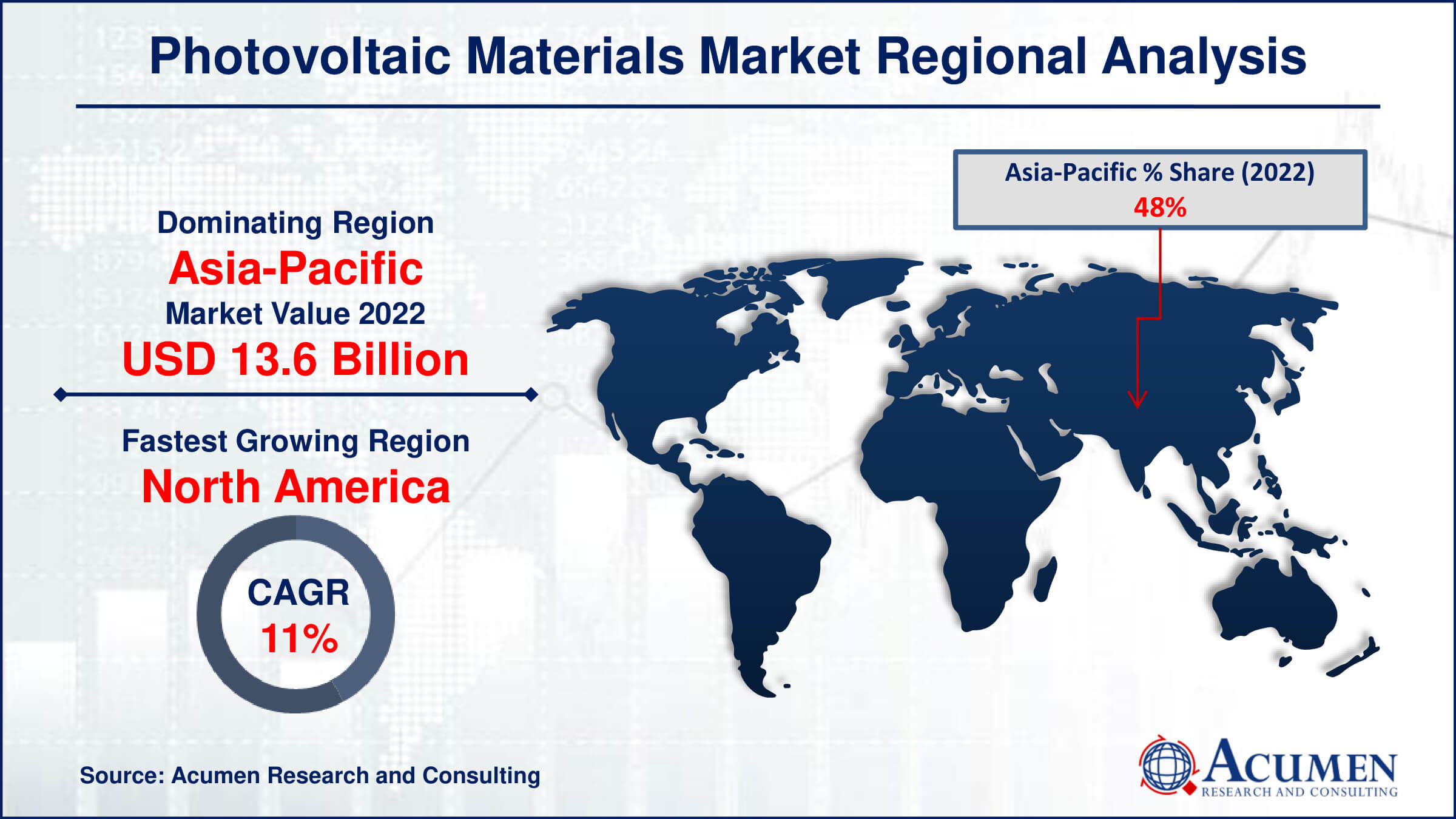November 2024
Photovoltaic Materials Market Size accounted for USD 28.4 Billion in 2022 and is estimated to achieve a market size of USD 73.5 Billion by 2032 growing at a CAGR of 10.1% from 2023 to 2032.
The Photovoltaic Materials Market Size accounted for USD 28.4 Billion in 2022 and is estimated to achieve a market size of USD 73.5 Billion by 2032 growing at a CAGR of 10.1% from 2023 to 2032.
Photovoltaic Materials Market Highlights

A significant portion of the renewable energy industry is covered by the photovoltaic materials market, which focuses on the materials used to make solar cells for photovoltaic panels. The primary function of these panels is to transform light energy into electrical current, which allows solar power to be used for a variety of purposes. The fundamental elements of photovoltaic cells are semi-conductive materials, which allow the effective conversion of solar radiation into electrical energy. They may be customized to fit a variety of installations and surface layouts depending on the available area and environmental factors. The solar energy business is driven by innovation due to the ongoing developments in photovoltaic materials, which in turn facilitate the wider acceptance and integration of sustainable energy solutions into many industries globally.
Global Photovoltaic Materials Market Dynamics
Market Drivers
Market Restraints
Market Opportunities
Photovoltaic Materials Market Report Coverage
| Market | Photovoltaic Materials Market |
| Photovoltaic Materials Market Size 2022 | USD 28.4 Billion |
| Photovoltaic Materials Market Forecast 2032 | USD 73.5 Billion |
| Photovoltaic Materials Market CAGR During 2023 - 2032 | 10.1% |
| Photovoltaic Materials Market Analysis Period | 2020 - 2032 |
| Photovoltaic Materials Market Base Year |
2022 |
| Photovoltaic Materials Market Forecast Data | 2023 - 2032 |
| Segments Covered | By Material Type, By Product, By End Use, And By Geography |
| Regional Scope | North America, Europe, Asia Pacific, Latin America, and Middle East & Africa |
| Key Companies Profiled | Atecom Technology Co., Ltd., Shin-Etsu Chemicals Co., Ltd., Hemlock Semiconductor Corporation LLC, DuPont, Targray Technology International, Inc., Topray Solar, Hangzhou First Applied Material Co. Ltd., Mitsubishi Material Corporation, NovoPolymers NV, American Elements, and Ferrotec Corporation. |
| Report Coverage |
Market Trends, Drivers, Restraints, Competitive Analysis, Player Profiling, Covid-19 Analysis, Regulation Analysis |
Photovoltaic Materials Market Insights
The market for solar photovoltaic is being driven primarily by the need to switch to renewable resources and the growing demand for clean energy. This increase in demand is mostly caused by the urgent need to lessen the negative consequences of climate change, which is being exacerbated by the rising emissions from fossil fuels. As a result, the market for solar photovoltaic grows concurrently, driven by the increasing need for sustainable energy solutions. Consequently, there is a direct increase in demand for photovoltaic materials, which are necessary for the production of solar cells. The growing use of solar cell modules in a variety of applications from large-scale utility projects to rooftop installations on residential properties makes this need more noteworthy. The growing worldwide footprint of solar energy generation is reflected in the photovoltaic materials industry.
By increasing their investments in solar power generation, governments throughout the globe are playing a crucial role in promoting the growth of the solar photovoltaic market. The infrastructure for renewable energy is to be strengthened by these expenditures, and solar energy system adoption is to be encouraged. These kinds of programs help to foster a market expansion atmosphere, which in turn fuels the need for solar materials. Notwithstanding the encouraging development trajectory, there are still obstacles to overcome, chief among them being the hefty installation expenses linked to solar energy systems. Widespread adoption is discouraged by these expenses, especially in areas with little funding or insufficient legislative assistance. However, there is a bright side: the expected drop in the price of photovoltaic materials offers room for expansion, particularly in developing nations.
Photovoltaic Materials Market Segmentation
The worldwide market for photovoltaic materials is split based on material type, product, end use, and geography.
Photovoltaic (PV) Materials Market by Material Types
According to photovoltaic materials industry analysis, the monocrystalline silicon usually has the largest share among the material types listed. Because of its superior electrical characteristics and long-term dependability, monocrystalline silicon which is valued for its high efficiency and durability remains the preferred option for the production of solar cells. Monocrystalline silicon is a favored material for both residential and commercial solar installations because of its consistent structure, which facilitates the effective conversion of sunlight into power. Furthermore, improvements in production methods have streamlined manufacturing procedures, lowering prices and strengthening monocrystalline silicon's market dominance. Due to its superior performance and broad acceptance in the solar sector, monocrystalline silicon continues to hold the top spot in the market even if other materials like polycrystalline silicon and thin-film technologies provide alternatives.
Photovoltaic (PV) Materials Market by Products
The back sheet sector typically has the largest market share in the PV materials industry and it will expected to grow continue during the photovoltaic materials industry forecast period. Back sheets serves as protective coatings on the back of solar panels, offering electrical insulation and sheltering them from the elements. There are several reasons for the Back Sheet segment's prominence. First and foremost, back sheets are necessary to protect solar modules from mechanical stress, UV rays, and moisture intrusion while also assuring their structural integrity and durability. Second, improvements in back sheet materials' resilience and performance under challenging operating circumstances have been made possible by the use of fluoropolymer-based films and multi-layer laminates. Furthermore, the demand for back sheets is fueled by the growing deployment of solar photovoltaic systems across a variety of applications, including utility-scale installations, commercial buildings, and homes, further strengthening its position as the market leader for photovoltaic materials.
Photovoltaic (PV) Materials Market by End Uses
The utility category usually holds the largest share in the photovoltaic materials market. The primary factor for this domination is the global deployment of utility-scale solar photovoltaic (PV) plants. Utility-scale installations are becoming more and more appealing for achieving renewable energy objectives and addressing the demand for electricity because of their many benefits, which include economies of scale, effective land use, and centralized power generation. Additionally, in order to diversify their energy portfolios and take advantage of government subsidies and renewable energy laws, utility firms and independent power producers (IPPs) are making large-scale investments in solar projects. Furthermore, utility-scale solar's competitiveness has been further enhanced by decreasing prices and advances in PV technology, which has led to significant development in this market. Because it accounts for the most portion of the demand for solar materials, the Utility sector emerges as the market leader in the photovoltaic materials market.
Photovoltaic (PV) Materials Market Regional Outlook
North America
Europe
Asia-Pacific
Latin America
The Middle East & Africa

Photovoltaic Materials Market Regional Analysis
As per the photovoltaic materials market analysis, Asia-Pacific is the largest region with a sizable part of the market. Numerous factors contribute to its supremacy. First off, the economies of China, Japan, and India some of the biggest economies in the worlds well as the region's renewable energy installations and investments are growing rapidly. These nations' aggressive goals for renewable energy and their pro-renewable laws are creating a significant demand for photovoltaic materials. Furthermore, the region's dominance in the market is a result of the existence of well-established manufacturing facilities and a sizable supply chain network in nations like China.
In contrast, the market is expanding at the quickest rate in North America and it will grow over the photovoltaic materials market forecast period. Numerous variables contribute to this development trajectory. First off, favorable federal and state laws, incentives, and regulations have caused a boom in solar energy installations across North America, especially in the United States. Advances in photovoltaic technology and growing consumer consciousness of environmental sustainability further contribute to the acceleration of solar power system adoption in the area for residential, commercial, and utility-scale applications. In addition, the decreasing prices of solar panels and photovoltaic materials make solar energy investments more appealing in North America.
Photovoltaic Materials Market Players
Some of the top photovoltaic materials companies offered in our report includes Atecom Technology Co., Ltd., Shin-Etsu Chemicals Co., Ltd., Hemlock Semiconductor Corporation LLC, DuPont, Targray Technology International, Inc., Topray Solar, Hangzhou First Applied Material Co. Ltd., Mitsubishi Material Corporation, NovoPolymers NV, American Elements, and Ferrotec Corporation.
Looking for discounts, bulk pricing, or custom solutions? Contact us today at sales@acumenresearchandconsulting.com
November 2024
February 2025
October 2022
December 2024